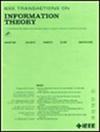N-Sum Box: An Abstraction for Linear Computation Over Many-to-One Quantum Networks
IF 2.2
3区 计算机科学
Q3 COMPUTER SCIENCE, INFORMATION SYSTEMS
引用次数: 0
Abstract
Linear computations over quantum many-to-one communication networks offer opportunities for communication cost improvements through schemes that exploit quantum entanglement among transmitters to achieve superdense coding gains, combined with classical techniques such as interference alignment. The problem becomes much more broadly accessible if suitable abstractions can be found for the underlying quantum functionality via classical black box models. This work formalizes such an abstraction in the form of an “N-sum box”, a black box generalization of a two-sum protocol of Song et al. with recent applications to N-server private information retrieval. The N-sum box has a communication cost of N qudits and classical output of a vector of求助全文
约1分钟内获得全文
求助全文
来源期刊

IEEE Transactions on Information Theory
工程技术-工程:电子与电气
CiteScore
5.70
自引率
20.00%
发文量
514
审稿时长
12 months
期刊介绍:
The IEEE Transactions on Information Theory is a journal that publishes theoretical and experimental papers concerned with the transmission, processing, and utilization of information. The boundaries of acceptable subject matter are intentionally not sharply delimited. Rather, it is hoped that as the focus of research activity changes, a flexible policy will permit this Transactions to follow suit. Current appropriate topics are best reflected by recent Tables of Contents; they are summarized in the titles of editorial areas that appear on the inside front cover.
 求助内容:
求助内容: 应助结果提醒方式:
应助结果提醒方式:


